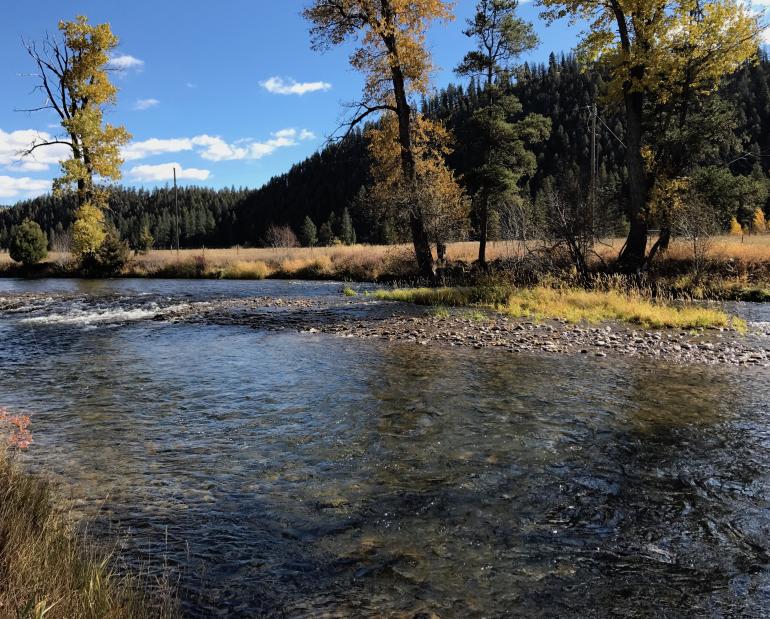A Fall Tradition
Fishing Rock Creek.
Nestled in the mountains between Missoula and Philipsburg, there is a creek that exemplifies the essence of a true Montana trout stream—Rock Creek. My father and I have been coming here for years, and it's not just the abundance of trout and hatches that bring us back every fall. It's the hues of red and orange scattered throughout the hillsides, it's the chance to see a wandering moose or a soaring hawk, it's getting away from the hectic pace of everyday life, but most of all it's a chance to trick some trout with the man who tossed a fly rod into my youthful hands years ago.
Driving along the dusty, pothole littered road, conversation fills the truck from the works of Hemingway to the heavy blues-influence found in L.A. Woman, when we begin to notice Rock Creek shimmering in the morning sun. The willow-covered shores, deep holes, fallen trees, and riffled shelves leave us wanting to pull over every couple hundred yards. But, we keep moving.
Come October, most anglers are stripping streamers for aggressive fish, but Dad and I have something else in mind—delicately presenting dry flies to eager trout. Rock Creek is home to prolific hatches throughout the year, and provides for some lights-out dry-fly activity. It’s a harmonic time of year: mayflies are fluttering through the air dancing in their newly formed bodies; blue wing olives are emerging from the depths of the river’s womb by the dozens; and large, October Caddis are clumsily bouncing through the air. Birthed from the womb of the river, these bugs wait to be slurped, gulped, and devoured by hungry trout. To fly fisherman, this is a thing of a beauty.
So there we are, pulling up to the access, alarmed. A group of anglers is about a hundred yards upriver, and we need to make our way a quarter mile past them. Car thrown in park, we hop out in fire drill-style and furiously assemble our gear. The race begins. Weaving through a labyrinth of fall colors we dip into the stream, take a glance around, and realize there is nobody ahead of us. Success, we have left the last of human interaction behind us—just us and Rock Creek.
As the sun sits in the high-noon sky, we begin. Knowing there are fish in this section of the river, we present all sorts of suitable dries and nymphs, but nothing. Dead. As we are throwing cast after cast at the fishiest of runs, holes, and banks we get nothing—it’s too early. In the fall, mornings are slow, the water has to reach just the right temperature for the river to release the hatch. When the hatch begins, trout get in line, and mayhem breaks loose.
With luck in the past, I decide to check out one of the smaller six-foot-wide creeks that run into the main stem. With the rhythmic sound of flowing water soothing my thoughts, I find peace in this intimate creek, relishing the isolation. I take in the beauty of an autumn day and realize the fish are only a fraction of the experience. I crawl steathily along the creek, and see fish finning on the banks. After several false casts snagged in the shoulder-high grass, I gently lay my size 18 purple haze on the gin-clear water. As the fly floats closer and closer to me it happens—a ferocious strike from a brown. A few fish later, I form a hypothesis: the water in this creek has reached the ideal temperature. After about an hour of sneaking around this minuscule creek, it's time to check in with Dad, who knew the wait would be worth it, and see if the mayhem has begun.
Emerging from the brush, I notice Dad's rod bent from a cutthroat yanking on the other side, as he shouts, “You better get out here, it's started.” Like a scheduled lunch, it's 2 o’clock, the mayflies are out, and the trout are biting. I toss my line a few times in a riffled run, and after a few drifts, a red-bellied cutthroat engulfs my purple haze. Lunch is served and the trout are not going to pass up a meal. Giddy with ear-to-ear smiles, my father and I are plucking cutthroats, browns, and the occasional rainbow on every other cast. With "I got one," drowning out the soothing sound of the river for three hours, it comes to a stand still.
The sun starts to creep behind the colorful hillside, signifying lunch is over. The trout’s bellies are full, and we feel a slight burn in our arms from a successful day. As I throw my last few hopeful casts of the day, I start to reflect. I look around and think about the countless fish, clouds of bugs, scenery Dad and I had just experienced. But it's more than that. It's about continuing a fall tradition with the man who taught me how to fish.
As we mosey back to the truck, everything seems to fall in place. Beers are enjoyed, laughs are had, and reality rapidly approaches. It's another another tally added to our tradition. Soon, we would part ways back to reality—to the confines of school and work. Till next year, Rock Creek.











